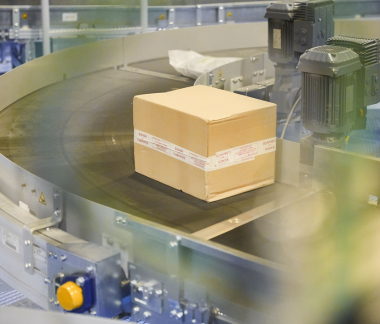Logistics platforms: adapting the maintenance of industrial machines to the risk of a shortage of spare parts
In the world of industry, ensuring good industrial maintenance of production equipment is essential to maintain the productivity of logistics activities in warehouses. To do this, maintenance technicians carry out regular maintenance of industrial machines, using a CMMS tool that allows them to monitor interventions and causes, as well as to manage spare parts stocks.
On this last point, the political tensions on the world stage are putting a strain on the replenishment of spare parts and maintenance technicians must be proactive.
How can you ensure that your spare parts stocks are properly managed?
The complexity of managing inventories and having sufficient space requires a solid strategy for controlling and monitoring spare parts stocks. For the maintenance teams, it is a real balancing act that they must carry out on all the parts references in order to constitute a "fair" stock guaranteeing the continuity of the production chain. This requires taking into account wear and tear (rotation), criticality levels, end of series, as well as questioning the location of stocks.
Data-driven monitoring of replenishment thresholds
Companies with expertise in industrial maintenance, such as Viaposte, use data to manage their maintenance activities.
In terms of spare parts management, the maintenance teams set up alert thresholds so that they are automatically warned when a part reference reaches a critical stock level: The more frequently a part is consumed, the higher the alert threshold. If a risk of shortage is identified or if supply times are extended, this threshold can be adjusted," explains Pierre-Henry. In addition, all the maintenance technicians' interventions are monitored in their CMMS tool. They enter reports on preventive maintenance, breakdowns, repairs to parts in the workshop, consumption of spare parts and improvement projects.
"Tomorrow, we could even hope that artificial intelligence, fed by sensors installed on the equipment, will replace this operation of entering data into the CMMS by technicians. By having the machine data enriched by the intervention data, we would be well on the way to predictive maintenance, but we are not there yet," says Pierre-Henry.
The choice of location of parts stocks for industrial maintenance
Working on the industrial maintenance of its own logistics equipment and that of customers such as La Poste and Relais Colis, Viaposte chose to set up a central spare parts warehouse in the Ile-de-France region: "We preferred to manage our stock centrally rather than by establishment in order to optimise storage space and the rotation of parts. We chose a location that connects to the whole of France," says Pierre-Henry.
"One of the problems is maintaining equipment without having all the spare parts and with thousands of references. It is therefore important to choose the right parts and put them in the right place to be as close as possible to the points of intervention", says Pierre-Henry BARBEAU, Industrial Maintenance Method Manager at Viaposte.

How to reduce spare parts lead times?
If a machine stops, the entire supply chain is interrupted. Reactivity in resolving breakdowns is therefore essential. This race against time has a direct impact on the way in which the supply of spare parts is managed.
Expanding the pool of suppliers and manufacturers of logistics equipment parts
Viaposte favours sourcing from SME-type suppliers in machining or boiler making and close to the production sites on which the company operates in order to limit delivery times and encourage local work: "We pay close attention to the quality of the parts as well as to production responsiveness. These are the two main criteria for us, while also working on pricing in view of the quantities ordered," explains Pierre-Henry.
On the other hand, "in the current context, companies are seeking to secure their production tools by overstocking, thus creating an anticipated shortage of certain references. We have therefore started to work on the counter-typing of mechanical parts.”
This counter-typing consists of having any manufacturer produce a spare part from an existing part, either by repairing it or by creating a new one with the same functionality. In this way, maintenance teams are able to reduce manufacturing times and costs by sourcing parts more easily.
Looking closely at the 3D printing alternative
3D printing has been in the spotlight for a few years now. Instead of managing stocks of multiple references, some are thinking about manufacturing on demand.
This technology is of interest for old equipment parts, which are no longer produced but are still used by logisticians. Obviously, it cannot be used for all parts. "It is a possibility for small plastic parts with a very high yield so that the acquisition of a 3D printing machine becomes profitable. For example, it makes sense to replace parts for sorters that are in high demand at certain times, such as those used by Viaposte or La Poste, which run at full capacity over the end of the year period," says Pierre-Henry.
And tomorrow by integrating an environmental dimension?
Viaposte wants to go further by integrating environmental concerns into the management of its customers' spare parts. The company's maintenance teams want to work on the possibilities of recycling spare parts. "We are always full of ideas to develop our business and meet our customers' requirements. The idea would be to be able to recycle machine parts that are destined for the scrap heap, but this implies finding machines that are identical to those of our customers," concludes Pierre-Henry BARBEAU.
Viaposte carries out maintenance of industrial equipment
Viaposte supports logistics companies in the maintenance of their industrial machines with technicians working throughout France:
- in a shift team, integrated daily into the heart of the customer's logistics activity
- in partial presence through regular interventions, agreed or on request
- intervention on the basis of an estimate in the context of a specific need








